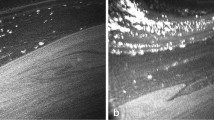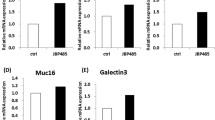Abstract
Background
Full-term neonates produce tears normally, but neonatal tear film is modified to resist evaporation with a thick lipid layer that allows lower spontaneous blink rates. This adaptation presumably prevents drying of the ocular surface during long inter-blink periods. However, tear-film stability is not only based on the integrity of the lipid layer, but also reflects properties of the underlying mucus layer. Characteristics of the neonatal mucus tear-film layer have not yet been described.
Materials and methods
Tear samples were obtained from eight full-term healthy neonates (four males, four females, mean age 1.7 ± 0.5 days) and eight healthy adult controls (four males, four females, mean age 26.3 ± 2.5 years). Characterization of tear samples’ total proteins was obtained by spectrophotometry. Western blot for major secretory mucin MUC5AC was performed on the samples. Blink rate in the neonates and adults enrolled in the study was also observed and recorded.
Results
Using the same procedure, the amount of tears collected was significantly greater in adults than in neonates (p < .01). Western Blot performed on neonatal tear samples showed a significant 76.8% increase in the expression of major secretory mucin MUC5AC as compared to healthy adult controls (p < .001). Mean blink rate recorded in neonates was significantly lower than in adults (p < .001), with a mean 1.6 ± 0.5 blinks per minute and a mean interblink time of 33 ± 9 seconds.
Discussion
As far as we are aware this is the first description of the mucus tear-film layer in neonates. The greater tear-film stability in neonates has been so far attributed to a thicker lipid layer. In our study, we show that a concomitant increase in MUC5AC protein expression in tears is present and may contribute to this greater stability; therefore, both mucus and lipid layer should be considered while evaluating tear film stability in neonates.



Similar content being viewed by others
References
Akar Y, Cira A, Apaydin C, Erman MA, Yilmaz A (2004) The effect of prematurity on tear production. Curr Eye Res 28(2):145–151
Argueso P, Balaram M, Spurr-Michaud S et al (2002) Decreased levels of the goblet cell mucin MUC5AC in tears of patients with Sjogren syndrome. IOVS 43(4):1004–1011
Apt L, Cullen BF (1964) Newborns do secrete tears. JAMA 189:951–953
Berry M, Ellingham RB, Corfield AP (2004) Human preocular mucins reflect changes in surface physiology. Br J Ophthalmol 88:377–383
Gipson IK (2004) Distribution of mucins at the ocular surface. Exp Eye Res 78(3):379–388
Gipson IK, Argueso P (2003) Role of mucins in the function of the corneal and conjunctival epithelia. Int Rev Cytol 231:1–49
Isenberg SJ, Apt L, McCarty JA et al (1998) The development of tearing in preterm and term neonates. Arch Ophthalmol 116:773–776
Isenberg SJ et al (2003) The lipid layer and sability of the preocular tear film in newborns and infants. Ophthalmology 110(7):1408–1411
Jumblatt MM, McKenzie RW, Jumblatt JE (1999) MUC5AC mucin is a component of the human precorneal tear film. Invest Ophthalmol Vis Sci 40(1):43–49
Lawrenson JG, Birhah R, Murphy PJ (2005) Tear-film lipid layer morphology and corneal sensation in the development of blinking in neonates and infants. J Anat 206(3):265–270
Lawrenson JG, Murphy PJ, Esmaeelpour M (2003) The neonatal tear film. Cont Lens Anterior Eye 26(4):197–202
Lopez-Cisternas J, Castillo-Diaz J, Traipe-Castro L, Lopez-Solis RO (2006) Use of polyurethane minisponges to collect human tear fluid. Cornea 25(3):312–318
Mantelli F et al (2006) Conjunctival mucin deficiency in complete androgen insensitivity syndrome (CAIS). Graefes Arch Clin Exp Ophthalmol. Nov 22 [Epub ahead of print]
Menon GJ (2000) Lacrimal secretion in the neonate. Arch Ophthalmol 118:861
Paulsen F, Langer G, Hoffmann W, Berry M (2004) Human lacrimal gland mucins. Cell Tissue Res 316:167–177
Rohatgi J, Gupta VP, Mittal S, Faridi MM (2005) Onset and pattern of tear secretions in full-term neonates. Orbit 24(4):231–238
Rolando M, Zierhut M (2001) The ocular surface and tear film and their dysfunction in dry eye disease. Surv Ophthalmol 45(2):s203–s210
Schlote T, Kadner G, Freudenthaler N (2004) Marked reduction and distinct patterns of eye blinking in patients with moderately dry eyes during video display terminal use. Graefes Arch Clin Exp Ophthalmol 242:306–312
Sharma A, Ruckenstein E (1985) Mechanism of tear film rupture and its implications for contact lens tolerance. Am J Optom Physiol Opt 62(4):246–253
Sjogren H (1955) The lacrimal secretion in newborn, premature, and fully developed children. Acta Ophthalmol 33:557–560
Toker E, Venice O, Ogut MS, Akman I, Ozek E (2002) Tear production during the neonatal period. Am J Ophthalmol 133:746–749
Watanabe H (2002) Significance of mucin on the ocular surface. Cornea 21(2 Suppl 1):s17–s22
Zametkin AJ, Stevens JR, Pittman R (1979) Ontogeny of spontaneous blinking and of habituation of the blink reflex. Ann Neurol 5:453–457
Author information
Authors and Affiliations
Corresponding author
Rights and permissions
About this article
Cite this article
Mantelli, F., Tiberi, E., Micera, A. et al. MUC5AC overexpression in tear film of neonates. Graefes Arch Clin Exp Ophthalmol 245, 1377–1381 (2007). https://doi.org/10.1007/s00417-007-0602-9
Received:
Revised:
Accepted:
Published:
Issue Date:
DOI: https://doi.org/10.1007/s00417-007-0602-9




